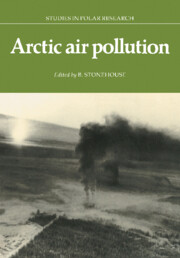Book contents
- Frontmatter
- Contents
- CONTRIBUTORS TO THIS VOLUME
- FOREWORD
- INTRODUCTION: INTERNATIONAL SYMPOSIUM ON ARCTIC AIR POLLUTION
- Part 1 Composition, source areas and transport pathways
- Arctic air chemistry: an overview
- Physical and chemical properties of arctic aerosols and clouds
- The Greenland aerosol: elemental composition, seasonal variations and likely sources
- Origin and characteristics of aerosols in the Norwegian Arctic
- Problems of air quality in local arctic and sub-arctic areas and regional problems of arctic haze
- Who's polluting the Arctic? Why is it so important to know? An American perspective
- Part 2 Local, regional, global, ecological and climatic implications
- Part 3 Health and ecological issues
- Part 4 International cooperation and state responsibility
- 5 Conclusions
- Index
Problems of air quality in local arctic and sub-arctic areas and regional problems of arctic haze
Published online by Cambridge University Press: 03 May 2010
- Frontmatter
- Contents
- CONTRIBUTORS TO THIS VOLUME
- FOREWORD
- INTRODUCTION: INTERNATIONAL SYMPOSIUM ON ARCTIC AIR POLLUTION
- Part 1 Composition, source areas and transport pathways
- Arctic air chemistry: an overview
- Physical and chemical properties of arctic aerosols and clouds
- The Greenland aerosol: elemental composition, seasonal variations and likely sources
- Origin and characteristics of aerosols in the Norwegian Arctic
- Problems of air quality in local arctic and sub-arctic areas and regional problems of arctic haze
- Who's polluting the Arctic? Why is it so important to know? An American perspective
- Part 2 Local, regional, global, ecological and climatic implications
- Part 3 Health and ecological issues
- Part 4 International cooperation and state responsibility
- 5 Conclusions
- Index
Summary
ABSTRACT. A strong and persistent air temperature inversion at ground level, resulting from outgoing radiation, is a feature of Arctic and sub-Arctic regions. In sheltered valleys the lowest air layers become extremely stable and prone to pollution. Temperature gradients of 30°C per 100 m are common in the lowest 50 m. The stable air structure extends 1 or 2 km upward from the surface and permits transport of pollutants from mid-latitudinal sources in sheet-like layers across the Arctic with negligible vertical dispersion. This produces widespread Arctic haze, most effectively in winter and early spring during cold, dry periods when the air is stable and well-stratified, and ending in April when conditions become turbulent and moist. Considering the distances involved, the concentration of pollutants in the haze seems surprisingly high, but it is a natural consequence of exceptionally stable air. Urban haze is most intense during December and January, when the inversions are undisturbed even at midday: pollution levels in a small community like Fairbanks during winter can equal or exceed those of large industrial, urban centres with populations two orders of magnitude larger, such as Detroit, Los Angeles or New York. Local winter problems become especially acute at latitudes north of 60° in continental regions such as Siberia, interior Alaska and Canada.
- Type
- Chapter
- Information
- Arctic Air Pollution , pp. 69 - 84Publisher: Cambridge University PressPrint publication year: 1987
- 1
- Cited by



